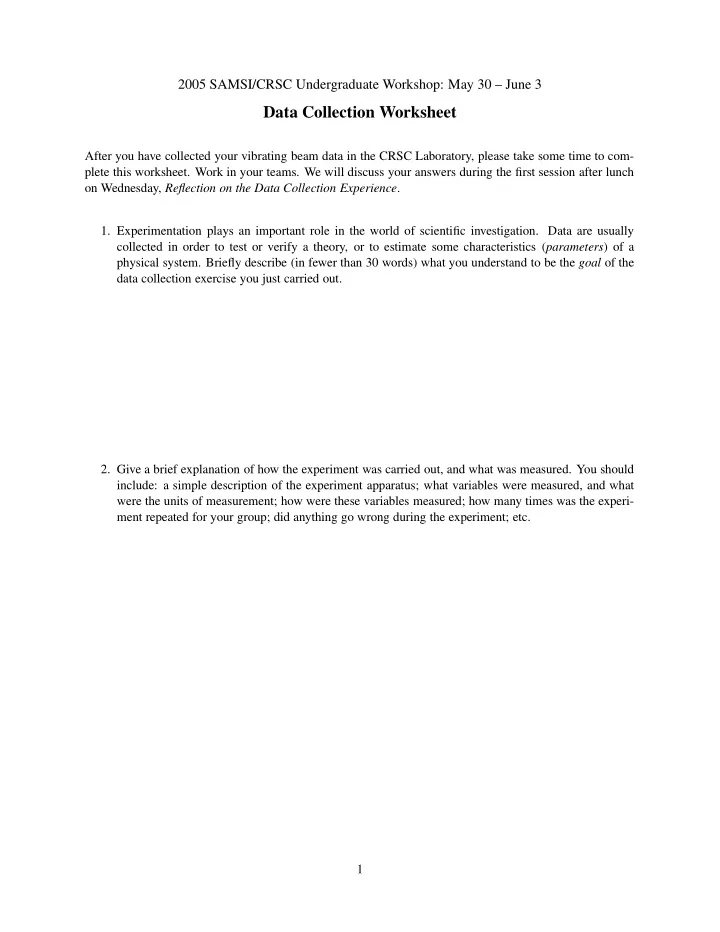

2005 SAMSI/CRSC Undergraduate Workshop: May 30 – June 3 Data Collection Worksheet After you have collected your vibrating beam data in the CRSC Laboratory, please take some time to com- plete this worksheet. Work in your teams. We will discuss your answers during the first session after lunch on Wednesday, Reflection on the Data Collection Experience . 1. Experimentation plays an important role in the world of scientific investigation. Data are usually collected in order to test or verify a theory, or to estimate some characteristics ( parameters ) of a physical system. Briefly describe (in fewer than 30 words) what you understand to be the goal of the data collection exercise you just carried out. 2. Give a brief explanation of how the experiment was carried out, and what was measured. You should include: a simple description of the experiment apparatus; what variables were measured, and what were the units of measurement; how were these variables measured; how many times was the experi- ment repeated for your group; did anything go wrong during the experiment; etc. 1
✆ ✁ ✆ ✆ � ✆ ✆ � 3. During this workshop, you will learn how the displacement data collected in the CRSC Laboratory can be used to estimate the parameters (i.e., m , c and k ) of the model md 2 y cdy ky 0 (1) dt 2 dt that is thought to describe the motion of a vibrating beam (an example of a damped harmonic oscilla- tor). Actually, we will only be able to estimate the ratios c ✂ m and k ✂ m , but more on that later ✄☎✄☎✄ . Try to answer TRUE/FALSE to the following statements about estimation of the parameters based on the data that your group collected: Our parameter estimates would be applicable to all vibrating beams. Our parameter estimates would be applicable to all vibrating beams in North Carolina. Our parameter estimates would be applicable to all vibrating beams that had the same manufac- turing specifications as the one we used in the lab experiment. Our parameter estimates would be applicable only to the beam that we actually used in the experiment. Our parameter estimates would be applicable to all vibrating beams that had the same manu- facturing specifications, excited at the same frequency that we used, and only under identical laboratory conditions to the ones that were present when we conducted our experiment. 4. If you repeated the experiment a number of times (under similar conditions), do you think the observed displacement measurements would be identical in all repetitions? 5. If you said “no” in the previous question, write down some reasons why the measurements might differ from experiment to experiment. 2
✁ ✁ ✁ ✆ ✆ 6. On Tuesday you saw graphs of the model described in (1). The graphs show displacement, y ✁ , � t changing very smoothly over time. Later today or tomorrow, you will plot the data that you collected in the lab. Do you think your observed data will look as “smooth” as the model suggests it should? 7. If you said “no” to the previous question (and assuming that our model in (1) is “good”), write down some reasons why the data might show some small deviations from the trajectory that the model (with true values of m , c and k ) predicts. 8. In the light of your answers to previous questions ✄☎✄☎✄ Do you think we can precisely “nail down” (to a single number) our data-based estimate of each parameter characterizing the CRSC vibrating beam (under whatever conditions you decided where TRUE in question 3)? Which of the folllowing statements do you think is the most satisfactory way of describing the estimate of a parameter that we might make based on our data? Don’t worry about the actual value of the estimate; think of the nature of the statement. (a) We estimate that the parameter C c ✂ m for the CRSC beam excited at 6.15 Hz has value 0.9794. (b) We estimate that the parameter C c ✂ m for the CRSC beam excited at 6.15 Hz lies between 0.97 and 0.99. (c) We are 95% confident that the parameter C c ✂ m for the CRSC beam excited at 6.15 Hz lies between 0.97 and 0.99. 3
Recommend
More recommend